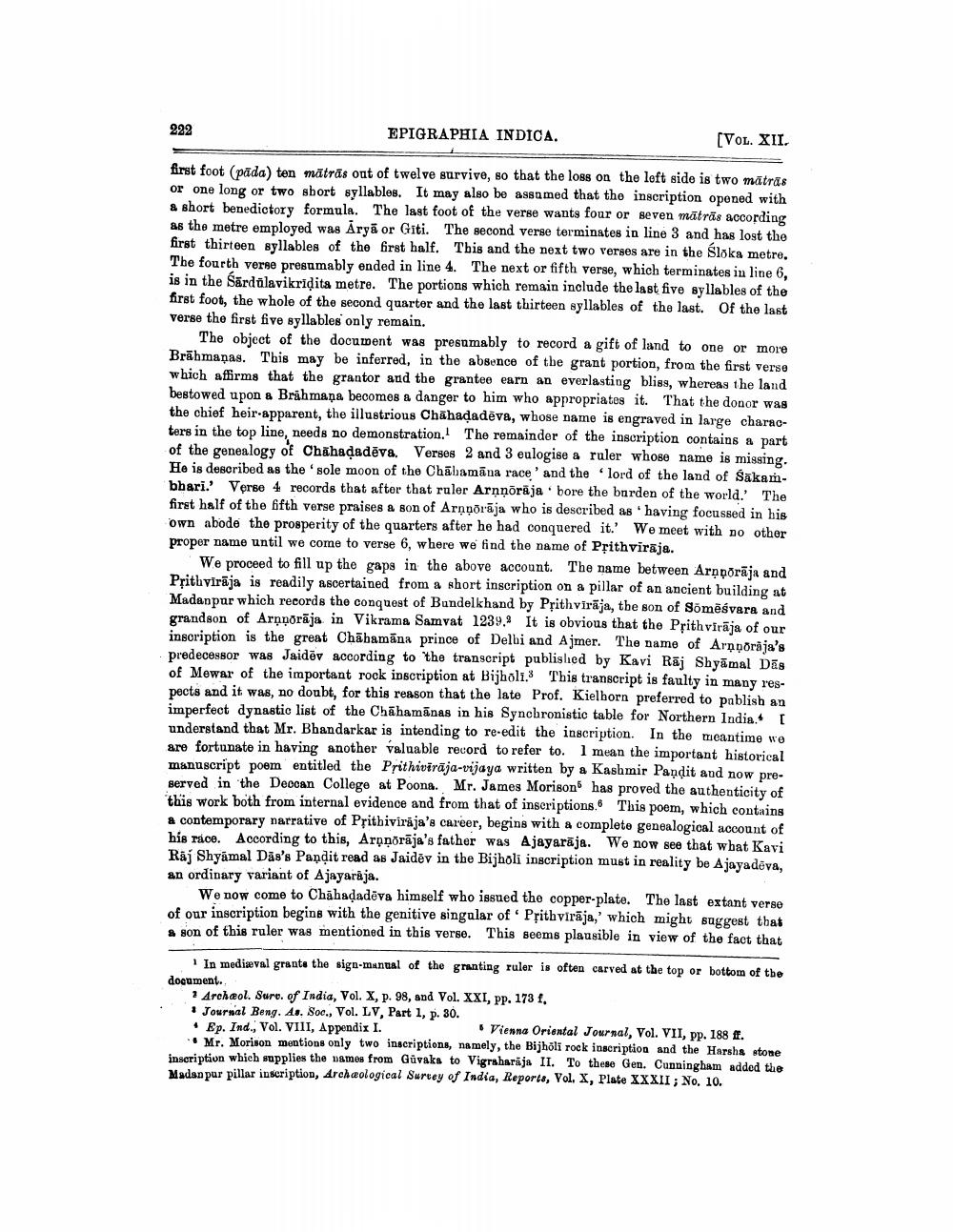________________
222
EPIGRAPHIA INDICA.
(VOL. XII.
first foot (pada) ten matras out of twelve survive, so that the loss on the left side is two matras or one long or two sbort syllables. It may also be assumed that the inscription opened with & short benedictory formula. The last foot of the verse wants four or seven mātrās according as the metre employed was Āryā or Giti. The second verse terminates in line 3 and has lost the first thirteen syllables of the first half. This and the next two verses are in the Sloka metre. The fourth verse presumably ended in line 4. The next or fifth verse, which terminates in line 6, is in the Sārdülavikridita metre. The portions which remain include the last five syllables of the first foot, the whole of the second quarter and the last thirteen syllables of the last. Of the last verse the first five syllables only remain.
The object of the document was presumably to record a gift of land to one or more Brāhmaṇas. This may be inferred, in the absence of the grant portion, from the first verse which affirms that the grantor and the grantee earn an everlasting bliss, whereas the land bestowed upon a Brahmana becomes a danger to him who appropriates it. That the donor was the chief heir-apparent, the illustrious Chāhadadēva, whose name is engraved in large characters in the top line, needs no demonstration. The remainder of the inscription contains a part of the genealogy of Chahadadēva. Verses 2 and 3 eulogise & ruler whose name is missing. He is described as the sole moon of the Chābamāna race and the lord of the land of Säkambhari. Verse 4 records that after that ruler Arnņörāja bore the burden of the world. The first half of the fifth verse praises a son of Ar pārāja who is described as having focussed in his own abode the prosperity of the quarters after he had conquered it. We meet with no other proper name until we come to verse 6, where we find the name of Prithviraja.
We proceed to fill up the gaps in the above account. The name between Arnporāja and Prithvirāja is readily ascertained from a short inscription on a pillar of an ancient building at Madanpur which records the conquest of Bundelkhand by Prithvirāja, the son of Sömēśvara and grandson of Arņņārāja in Vikrama Samvat 1239. It is obvious that the Prithviraja of our inscription is the great Chābamāna prince of Delhi and Ajmer. The name of Arnporaja's predecessor was Jaidev according to the transcript published by Kavi Rāj Shyamal Das of Mewar of the important rock inscription at Bijholi. This transcript is faulty in many respects and it was, no doubt, for this reason that the late Prof. Kielborn preferred to pablish an imperfect dynastic list of the Chāhamānas in his Synchronistic table for Northern India. [ understand that Mr. Bhandarkar is intending to re-edit the inscription. In the meantime we are fortunate in having another valuable record to refer to. I mean the important historical manuscript poem entitled the Prithivirāja-vijaya written by a Kashmir Pandit and now preserved in the Deccan College at Poona. Mr. James Morison has proved the authenticity of this work both from internal evidence and from that of inscriptions. This poem, which contains & contemporary narrative of Prithivirāja's career, begins with a complete genealogical account of bís race. According to this, Ar norāja's father was Ajayarāja. We now see that what Kavi Raj Shyamal Dās's Paņạit read as Jaidēv in the Bijholi inscription must in reality be Ajayadova, an ordinary variant of Ajayaraja.
We now come to Chahadadēva himself who issued the copper-plate. The last extant verse of our inscription begins with the genitive singalar of Přithvirāja,' which might suggest that & son of this ruler was mentioned in this verse. This seems plausible in view of the fact that
In medieval grants the sign-manual of the granting ruler is often carved at the top or bottom of the document.
1 Archæol. Suro. of India, Vol. X, p. 98, and Vol. XXI, pp. 173 f.
Journal Beng. As. Soc., Vol. LV, Part 1, p. 30. • Ep. Ind. Vol. VIII, Appendix I.
Vienna Oriental Journal, Vol. VII, pp. 188 ff. Mr. Morison mentions only two inscriptions, namely, the Bijholi rock inscription and the Harsha stone inscription which supplies the names from Gūvaks to Vigraharaja II. To these Gen. Cunningham added the Madan pur pillar inscription, Archeological Survey of India, Reports, Vol. X, Plate XXXII, No. 10.




